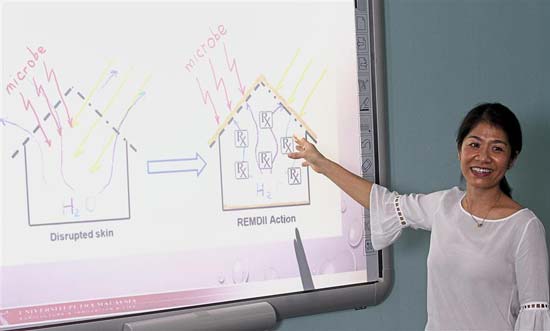



Professor Dr Lai Oi Ming of Universiti Putra Malaysia’s (UPM) Department of Bioprocess Technology had her first child in 2013. However, her initial joy was marred because he had an unexpected skin condition.
“My son had very severe eczema when he was born. I come from a family that does not have asthma, eczema or other allergic conditions, so I didn’t know how to deal with him,” she said.

At the time, the lipid and enzyme technology expert was working on a tocotrienols clinical trial with one of her Masters students.
Tocotrienols are one of the two forms of Vitamin E, with the other being tocopherols. They are differentiated by the type of chemical bonds they have in their side chain; tocotrienols have three double bonds, while tocopherols have single bonds. Both forms have four members, or isomers, each – namely, alpha, beta, gamma and delta.
Said Prof Lai: “From that trial, I knew that tocotrienols have very good anti-inflammatory properties; they have always been used for cardiovascular diseases, cancer, etc, but there wasn’t any study for eczema or atopic dermatitis [the most common form of eczema].
“So I decided to have a look at all the [eczema] creams that were out there; it was very frustrating to find out that most do not have anti-inflammatory properties – I just couldn’t wrap my head around that.
“Whenever I saw doctors, they would tell me there is no cure for eczema. That was even harder to accept because, in the 21st century, you would think that a skin condition would have a treatment. So, I decided to work on it.”
Studies have shown that in many cases, eczema patients do not have a protein known as filaggrin in the skin, said Prof Lai.

“This particular protein is supposed to protect the skin barrier so that the moisture below the skin doesn’t evaporate. At the same time, allergens and microbes from the outside are unable to penetrate the skin.”
Using the analogy of a house, Prof Lai explained the problems that eczema causes to the skin, and how the cream that she and her students developed has helped to solve those problems.
Without a properly-functioning barrier, the skin is unable to maintain its moisture, leading to the dry and scaly skin of eczema. Foreign substances are able to penetrate the skin, causing the inflammation that results in red and itchy rashes and, in severe cases, infection.
Eczema can occur at any age, although it more commonly begins in childhood or even infanthood. While some children outgrow this condition by the age of two, around half will continue to suffer from the chronic condition for life. Based on the latest available data from 2005, about a quarter of the Malaysian population has eczema.
Doctors take a two-prong approach for a flare-up – they prescribe a steroid to reduce the inflammation and tell patients to continuously moisturise. However, Prof Lai’s team discovered a problem with this.
“When we did a survey of all the creams in the market, we found that 90% don’t even have an active ingredient. Considering that eczema is an inflammatory skin condition, you would think that there should be some bioactive ingredient to reduce inflammation – an anti-inflammatory bioactive – but most of the creams do not have any.
“Of the 10% that do have it, some are synthetic ones. Most of the time, they only act on the surface [of the skin]. But inflammation happens in the dermal layer. That’s when we realised that something doesn’t match.”

Pages : 1 2